FY2013 Annual Report
Light-Matter Interactions Unit
Associate Professor Síle Nic Chormaic
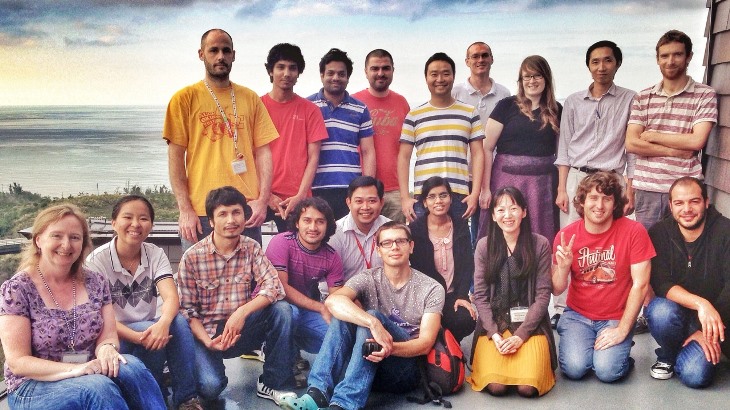
November 2013 (from left to right) Back row: Jonathan Ward, Nitesh Dhasmana, Ravi Kumar, Eugen Prel, Yong Yang, Kieran Deasy, Mary Frawley, Viet Giang Truong, Ciarán Phelan. Front row: Síle Nic Chormaic, Elaine Wong, Aili Maimaiti, Ramgopal Madugani, Vu Hong Le, Ivan Gusachenko, Vandna Gokhroo, Emi Nakamura, Mark Daly, Marios Sergides
Abstract
We are interested in studying the interaction between light and matter in a number of regimes, including cold atomic systems for advances in the development of quantum-based technologies, whispering gallery mode microresonators for sensing and optomechanics, and optical trapping of biologically relevant specimens. Our primary focus is to gain a better understanding of the processes involved through experiments and to use this knowledge for the manipulation and trapping of micron and submicron particles using light fields. A common technique across our work is the use of optical nanofibres as the interface tool between the light source and the sample under investigation.
1. Staff
- Dr. Síle Nic Chormaic, Associate Professor
- Ms. Emi Nakamura, Research Administrator
- Dr. Viet Giang Truong, Researcher
- Dr. Jonathan Ward, Researcher
- Dr. Kieran Deasy, Researcher
- Dr. Yong Yang, Researcher
- Dr. Vandna Gokhroo, Researcher
- Dr. Ivan Gusachenko, Researcher
- Dr. Ciarán Phelan, Researcher
- Dr. Marios Sergides - JSPS Postdoctoral Fellow
- Mr. Le Hong Vu, Technician
- Mr. Nitesh Dhasmana, Research Assistant
- Mr. Mark Daly, OIST PhD student
- Ms. Mary Frawley, UCC PhD/OIST special research student
- Mr. Ravi Kumar, UCC PhD/OIST special research student
- Mr. Ramgopal Madugani, UCC PhD/OIST special research student
- Mr. Aili Maimiati, UCC PhD/OIST special research student
- Mr. Eugen Prel, UCC MSc/OIST special research student
- Ms. Malehohonolo Gumede (Poppy Semonyo), UKZN PhD student
- Ms. E Laine Wong, OIST PhD Rotation Student (September-December 2013)
- Mr. Danny Riordan, Research Intern, UCC, Ireland (June-August 2013)
- Ms. Lisa Nakahara, Research Intern, University of Tsukuba, Japan (February-March 2014)
-
UCC: University College Cork, Ireland, UKZN: University Kwa-Zulu Natal, South Africa
2. Collaborations
- Theme: Coherent Quantum Control
- Type of collaboration: Joint research
- Researchers:
- Prof. Mikio Nakahara, Kinki University, Japan
- Prof. Mikio Nakahara, Kinki University, Japan
- Theme: SFI Ireland-Japan Collaboration Project
- Type of collaboration: Joint research
- Researchers:
- Dr Pengfei Wang, DIT, Ireland
- Dr Gerard Farrell, DIT, Ireland
- Dr Andy Ruth, UCC, Ireland
- Dr Andreas Ruschhaupt, Ireland
3. Activities and Findings
3.1 Higher Order Mode Propagation in Optical Nanofibres for Particle Trapping and Manipulation
3.1.1. Nanostructured optical nanofibres for atom and nanoparticle trapping
Monitoring and manipulation of matter down to the atomic level can be achieved within the confines of a rectangular slot located at the waist region of a silica optical micro/nanofibre [Figures 1 (a) and (b)]. When the fundamental mode of the unmodified region of the fibre meets the slot interface, the mode evolves into different modes which propagate along the upper and lower half of this slot waveguide-like region. The high confinement of the modes in this area produces an intense near-field within the slot thus allowing the trapping of atoms or nanoparticles both inside and outside the slot area. This results in several advantages over existing fibre-based traps, where the objects are trapped outside the fibre only. For example, in the case of atoms, the geometry can be adjusted to allow high atom-cavity coupling, and, for particles, propulsion and manipulation down to the nanoscale is possible. Figures 1 (a) and (b) show a schematic of such a slotted nanofibre. Figure 1(c) presents the theoretical calculation of a potential created for laser-cooled rubidium atoms, in the slot region of the micro/nanofibre via the use of blue- and red-detuned beams, with respect to the 85Rb cooling transitions. Results indicate that, for rubidium atoms, trap depths of 4 mK, coherence times of the order of 10 ms and trap lifetimes of approximately 100 s could be accessible using modest input powers. This scheme facilitates optical coupling between the atoms and the nanofibre that could be exploited for quantum communication schemes using ensembles of laser-cooled atoms.

Figure 1: (a) Schematic of a nanofibre with a slot present for a vacuum-fibre system n1 = 1 and n2 = 1.45991, (b) slot region only, and (c) trapping potential in slot region for a 1 μm diameter fibre with a 350 nm slot width (New J. Phys. 16 (2014) 053052).
3.1.2. Higher order mode propagation in optical nanofibres and nanostructured nanofibres for atom/nano-particle trapping
Based on our recent results, both theoretical and experimental, on the controlled generation of higher order modes in nanofibres [Opt. Commun. 285, 4648, (2012)], we investigated the capability to create and precisely control dielectric particles with different trapping geometries around a nanofibre using these TE01, TM01 and HE21 higher order modes. Through the interactions of the higher modes, complex 3D potentials can be created around, or even inside, a standard or structured micro/nanofibre. The purpose of this work was to generate 3D structured trapping sites to investigate molecular motions of cells, atos trapping, and simultaneous trapping and sorting of multiple micro- and nanoparticles in complex systems. Preliminary work related to the structured micro/nanofibre suggests that atom traps using the interaction of higher order modes in the blue-detuned regime can create such potentials.
3.2 Optomechanics
During FY2013, new experimental results were produced in whispering gallery mode optomechanics. The mechanism of micropendulum optomechanics properties were studied in depth. The micropendulum is a microsphere with a long thin flexible stem which supports ultra-high optical Q factors. Mechanically it is a cantilever-like oscillator so that it behaves just like a pendulum for its fundamental mode. In earlier work [Phys. Rev. A 85, 053820 (2012)], we have experimentally shown that the mechanical oscillation can be transduced into the optical transmission spectrum so that it can be detected by observing the Fourier transform of the transmission. The detuning of the laser to the WGM mode decides the amplitude of the transduced signal. When the laser is on the red side of the WGM, the signal seems to be amplified, while it is suppressed if it is on the blue side. It was believed that it was due to the thermal effect of the micropendulum; however, in FY2013, a new experiment was conducted to prove its origin using a new theoretical framework based on coupled mode theory (see Figure 2). This work was presented at CLEO 2014, USA.
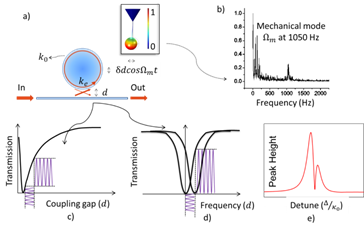
Figure 2: a) The principle of micropendulum coupled to a tapered fibre. The mechanical motion of the pendulum is transduced to optical transmission as b) shows. c) and d) are dissipative and dispersive mechanisms for such transduction. As a combination of both mechanisms, the opto-mechanical response to optical detuning gives an asymmetric curve shown as e).
We designed the experiment shown as Figure 3. A tunable 1550 nm laser source was coupled into the tapered fibre. The taper was evanescently coupled with the pendulum sphere by a 3D nanopositioner. The transmitted light through the pendulum’s microsphere was detected by a high gain photo detector and Fourier transformed (FT) on a digital oscilloscope. Note that the laser source was attenuated to a power of less than 100 nW to avoid the thermally induced dispersion.

Figure 3: (left) Experimental setup showing the micropendulum coupled to the tapered fibre. (right) The FT peak heights are recorded when the laser is scanned through an optical mode.
3.3 Microbubbles for Sensing Applications
In FY2012, we set up a microbubble fabrication system that can control the geometrical parameters of microbubbles made, with high optical Q factors (see Figure 4). By FY2013, both theoretical and experimental results developed further from it. We have discussed in detail what parameters are to be pursued for high resolution sensing. To achieve high sensing capability, the microbubble should be operated in the quasi-droplet regime. A definition of the quasi-droplet regime based on the effective refractive index is discussed. Using this definition and together with an accurate quality factor calculation by a finite element method (FEM), optimized resolution is obtained for refractive index (RI) and nanoparticle sensing applications. Published in Opt. Exp. 22, 6881 (2014).
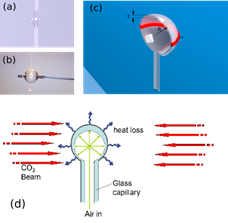
Figure 4: a) Double-pass and b) single-pass microbubbles. c) is the geometric structure of the microbubble.
d) CO2 laser fabrication method.
When the microbubble is filled with liquid (e. g. water), for a thin shell, the microbubble is more influenced by the liquid core than the silica shell. In this case, it might behave like a liquid microsphere, i.e. it is in the quasi-droplet regime. We used two different ways to describe it (Figure 5).
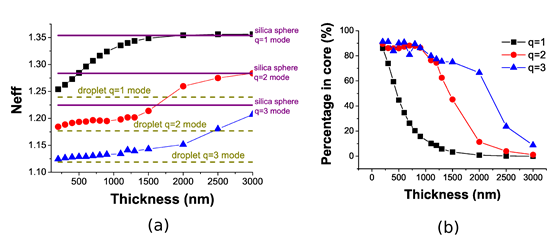
Figure 5: a) The effective index of q = 1, 2, 3 radial modes. b) The energy portion that is in the core for q = 1, 2, 3 modes in a microbubble. The thickness varies from 500 nm to 3 μm. Diameter of the microbubble is 50 μm.
Experimentally, the thermal shift rate was determined for different WGMS when the core of a microbubble was filled with air, water, and then ethanol. The experimental set is shown below.

Figure 6: The microbubble temperature is controlled using a Peltier heater.
Laser light at a wavelength of 775 nm from a mode-hop-free, tunable laser was coupled into the microbubble using a tapered optical fiber with a diameter ~ 1 μm and the WGMs were excited by scanning the laser over 80 GHz. The whole setup was placed inside an enclosure to remove external disturbances. To create thermal shifting of the WGMs, a large Peltier heating element was placed directly underneath the microbubble. The temperature in the vicinity of the microbubble was measured using a thermocouple. By controlling the current to the Peltier heater the temperature was increased in 0.1 K steps. The WGM frequency position was recorded continuously. The air-filled bubble was shifted over a larger temperature range. Sensitivities as high as 100 GHz/K (0.2 nm/K at wavelength of 775 nm) were observed when the microbubble core was filled with ethanol. This was the largest thermal shift rate reported for a WGM resonator. Q-factors for the higher order modes were typically 105, equivalent to a measurement resolution of 8.5 mK. This work was published in IEEE Phot. Tech. Lett. 25, 2350 (2013).
3.4 Optical Manipulation and Optical Detection of Biological System
Optical nanofibres, being very high-aspect ratio linear structures, represent a promising platform for mesoscopic particle manipulation and sorting, including biological applications. However, precise particle control and introduction of the particles to the fibre represents a challenge in these geometries. To address this problem we developed an experimental platform based on an optical tweezers setup, to precisely deposit prearranged sets of particles onto an optical nanofibre, thus facilitating experiments.
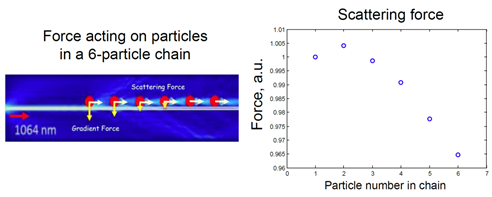
Figure 6: Left - schematic of forces in optical binding; Right - force as a function of the number of bound particles in a chain.
On this platform, we demonstrated organized propulsion of particle arrays, indicating optical binding, and performed both numerical and experimental study of this phenomenon on the transmitting optical nanofiber (see Fig. 7). The reason for a non-uniform particle grouping during propagation was elucidated with the help of numerical simulation in COMSOL Multiphysics package. Those results contribute to the ongoing study of optical binding and its applications for cell sorting.
3.5 Experiments on laser-cooled atoms with higher-order modes of an optical nanofibre
An optical nanofibre can be fabricated by the heat-and-pull technique such that it can support a few selected higher order modes at its waist. Light propagating in higher order modes can have higher exttension of the evanescent field around the waist in comparison with the fundamental mode and this leads to more interactions with the surrounding atoms. We experientially demonstrated that absorption by laser cooled Rubidium atoms around the waist of the nanofibre is higher when the probe light is sent through the higher modes than in the fundamental mode. Also, for the spontaneously emitted light coupling to the nanofibre through its waist it has higher coupling efficiency for higher order modes than for the fundamental mode.
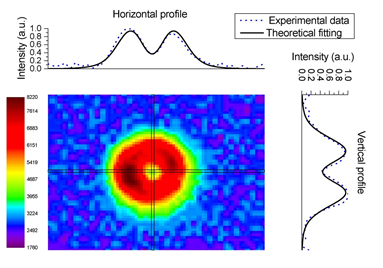
Fig. 8: Intensity of the light collected by a CCD camera at one output of the nanofibre when the trapping beams of the magneto-optical trap being coupled to the nanofiber through its waist. Horizontal and vertical profiles are fitted using a combination of the first higher and the fundamental modes in free space which indicates significantly higher coupling in the higher modes.
4. Publications
4.1 Journals
- Do, J., Sediq, K. N., Deasy, K., Coles, D. M., Rodriguez-Fernandez, J., Feldmann, J. & Lidzey, D. G. Photonic Crystal Nanocavities Containing Plasmonic Nanoparticles Assembled Using a Laser-Printing Technique. Advanced Optical Materials 1, 946-951, doi:10.1002/adom.201300214 (2013).
- Hosseini, E., Kasamatsu, K., Nic Chormaic, S., Takui, T., Kondo, Y., Nakahara, M. & Ohmi, T. Two-qubit gate operation on selected nearest-neighbor neutral atom qubits. Journal of the Physical Society of Japan 83, 044005, doi:http://dx.doi.org/10.7566/JPSJ.83.044005 (2014).
- Morrissey, M. J., Deasy, K., Frawley, M., Kumar, R., Prel, E., Russell, L., Truong, V. G. & Nic Chormaic, S. Spectroscopy, Manipulation and Trapping of Neutral Atoms, Molecules, and Other Particles Using Optical Nanofibers: A Review. Sensors 13, 10449-10481, doi:10.3390/s130810449 (2013).
- Nic Chormaic, S. Advanced Optics in an Interdisciplinary Graduate Programme. Proc. ETOP 2013 Twelfth International Topical Meeting on Education & Training in Optics and Photonics (2013).
- Nic Chormaic, S., Fee, S., Tobin, L. & Hennessy, T. Female role models in physics education in Ireland. AIP Conf. Proc. 1517, 110-111, doi:10.1063/1.4794244 (2013).
- Russell, L. Characterisation and spectroscopy of laser cooled atoms with a nanofibre. PhD Thesis, University Collage Cork, Ireland (2014).
- Russell, L., Kumar, R., Tiwari, V. B. & Nic Chormaic, S. Investigation of a 85Rb dark magneto-optical trap using an optical nanofibre. Measurement Science and Technology 25, 055203 (055208pp), doi:10.1088/0957-0233/25/5/055203 (2014).
- Russell, L., Kumar, R., Tiwari, V. B. & Nic Chormaic, S. Measurements on release–recapture of cold Rb-85 atoms using an optical nanofibre in a magneto-optical trap. Optics Communications 309, 313-317 (2013).
- Ward, J., Yang, Y. & Nic Chormaic, S. Liquid core microbubble resonators for highly sensitive temperature sensing. SPIE Proceedings, Laser Resonators, Microresonators, and Beam Control XVI 8960, 89601W-89601-89606, doi:10.1117/12.2038370 (2014).
- Watkins, A. Evanescent field sensing: optical nanofibres, whispering-gallery-mode microspherical and microbubble resonators. PhD Thesis, University College Cork (2013).
- Watkins, A., Tiwari, V. B., Ward, J. M. & Nic Chormaic, S. Observation of Zeeman shift in the rubidium D2 line using an optical nanofiber in vapor. Proc. SPIE 8785, 8th Iberoamerican Optics Meeting and 11th Latin American Meeting on Optics, Lasers, and Applications 8785, 87850S-87851-87856, doi:10.1117/12.2027163 (2013).
- Yang, Y., Ward, J. & Nic Chormaic, S. Quasi-droplet microbubbles for high resolution sensing applications. Optics Express 22, 6881-6898, doi:10.1364/OE.22.006881 (2014).
- Yang, Y., Ward, J. & Nic Chormaic, S. Optimization of whispering gallery modes in microbubble resonators for sensing applications. Proc SPIE 8960, Laser Resonators, Microresonators, and Beam Control XVI 8960, doi:10.1117/12.2037992 (2014).
4.2 Books and Other One-Time Publications
Not applicable
4.3 Oral and Poster Presentations
- Daly, M., Truong, V. G., Phelan, C., Deasy, K. & Nic Chormaic, S. Near-field trap for submicron particles and cold, neutral atoms using rectangular etched cavities in optical nanofibers, in FiO/LS 2013, Orlando, USA (2013).
- Deasy, K., Daly, M., Truong, V. G., Phelan, C. & Nic Chormaic, S. Nanostructured optical nanofibres for atom trapping, in Quantum Information Processing, Communication and Control 2, Kwazulu-Natal, South Africa (2013).
- Deasy, K., Daly, M., Truong, V. G., Phelan, C. & Nic Chormaic, S. Slotted tapered optical fibre atom trap, in International Workshop on the Fabrication and Application of Microstructured Optical Devices, Keio University, Yokohama, Japan (2014).
- Frawley, M., Petcu-Colan, A., Gusachenko, I., Truong, V. G. & Nic Chormaic, S. Higher order modes propagation in optical nanofibers, in FiO/LS 2013, Orlando, USA (2013).
- Frawley, M. C., Petcu-Colan, A., Maimaiti, A., Daly, M. G., I., Truong, V. G. & Nic Chormaic, S. Propulsion and manipulation of dielectric particle chains using optical nanofibres, in ONNA2013 Workshop, Seaside House, OIST, Japan (2013).
- Gokhroo, V., Kumar, R., Maimaiti, A., Deasy, K., Frawley, M. C. & Nic Chormaic, S. Studies on laser-cooled atoms interacting with fundamental and higher order modes of an optical nanofibre in IWQD 2014, Tokyo, Japan (2014).
- Gokhroo, V., Kumar, R., Maimaiti, A., Deasy, K. & Nic Chormaic, S. Experimental studies using an optical nanofibre integrated with cold atoms, in Quantum Information Processing, Communication and Control 2, Kwazulu-Natal, South Africa (2013).
- Gusachenko, I., Frawley, M., Maimaiti, A., Daly, M., Truong, V. G. & Nic Chormaic, S. Propulsion and trapping of chains of microspheres by an optical nanofiber integrated into an optical tweezers, in FiO/LS 2013, Orlando, USA (2013).
- Kumar, R., Gokhroo, V., Deasy, K. & Nic Chormaic, S. Optical nanofibres integrated into a MOT, in ONNA2013 Workshop, Seaside House, OIST, Japan (2013).
- Nic Chormaic, S. Advanced Optics in an Interdisciplinary Graduate Programme, in ETOP 2013, Porto, Portugal (2013).
- Nic Chormaic, S. Manipulating and trapping particles with optical nanofiber guided light, in Joint ISSP-OIST Symposium, OIST, Okinawa, Japan (2014).
- Phelan, C., Daly, M., Truong, V. G., Deasy, K. & Nic Chormaic, S. Cold atom trapping with a nanostructured optical nanofibre, in IWQD 2014, Tokyo, Japan (2014).
- Phelan, C., Hennessy, T., Frawley, M., Petcu-Colan, A., Truong, V. G., Busch, T. & Nic Chormaic, S. Nano-fiber atom traps based on high order modes, in FiO/LS 2013, Orlando, USA (2013).
- Truong, V. G., Frawley, M. C., Gusachenko, I. & Nic Chormaic, S. Multiple optical trapping and binding effects of microspheres in a nanofibre, in International Workshop on the Fabrication and Application of Microstructured Optical Devices, Keio University, Yokohama, Japan (2014).
- Ward, J., Yang, Y., Madugani, R. & Nic Chormaic, S. Sensing and optomechanics using whispering gallery microbubble resonators, in IEEE Photonics Conference, Bellevue Seattle (2013).
- Ward, J. M., Yang, Y. & Nic Chormaic, S. Temperature sensing with whispering gallery modes in a liquid filled microbubble, in ONNA2013 Workshop, Seaside House, OIST, Japan (2013).
- Watkins, A., Tiwari, V. B., Ward, J., Deasy, K. & Nic Chormaic, S. Observation of Zeeman shift in the Rb D2 line using an optical nanofiber in vapor, in RIAO/Optilas 2013, Porto, Portugal (2013).
- Yang, Y., Ward, J. & Nic Chormaic, S. Thermal-optical properties of microbubbles for sensing applications, in 4th Asia-Pacific Optical Sensors Conference, Wuhan, China (2013).
- Yang, Y., Ward, J. & Nic Chormaic, S. Optimization of whispering gallery modes in microbubble resonators for sensing applications, in LASE, SPIE Photonics West, San Francisco, USA (2014).
- Daly, M., G., T. V., Phelan, C. & Nic Chormaic, S. Near-field particle trapping in nanostructured optical nanofibers, in ICOLS 2013, Berkeley, USA (2013).
- Daly, M., Phelan, C., Truong, V. G., Frawley, M. & Nic Chormaic, S. Etched optical nanofibre cavities for cold atom and nanoparticle trapping, in Photonics Ireland 2013, Belfast, Northern Ireland (2013).
- Daly, M., Truong, V. G. & Nic Chormaic, S. Near-field submicron particle trapping using rectangular etched cavities of optical nanofibres, in ONNA2013 Workshop, Seaside House, OIST, Japan (2013).
- Deasy, K., Do, J., Sediq, K. N., Lutich, A. A., Rodríguez-Fernández, J., Feldmann, J. & G., L. D. Rapid nanoparticle positioning within an optical nanocavity, in ONNA2013 Workshop, Seaside House, OIST, Japan (2013).
- Frawley, M., Petcu-Colan, A., Maimaiti, A., Gusachenko, I., Truong, V. G. & Nic Chormaic, S. Optical nanofibres: Microparticle manipulation and higher mode generation, in ONNA2013 Workshop, Seaside House, OIST, Japan (2013).
- Frawley, M., Truong, V. G., Gusachenko, I. & Nic Chormaic, S. Optical nanofibres: particle trapping and binding, and higher order mode generation, in Photonics Ireland 2013, Belfast, Northern Ireland (2013).
- Frawley, M. C., Maimaiti, A., Truong, V. G. & Nic Chormaic, S. Optical Nanofibers: Microsphere Manipulation and Self-Assembly, and Higher Order Mode Generation, in Optical Trapping Applications, Waikoloa Beach, Hawaii, USA (2013).
- Gokhroo, V., Kumar, R., Deasy, K. & Nic Chormaic, S. Probing laser cooled atoms through a nanofibre, in ONNA2013 Workshop, Seaside House, OIST, Japan (2013).
- Gusachenko, I., Maimaiti, A., Frawley, M. C., Truong, V. G. & Nic Chormaic, S. Versatile optical tweezers workstation for spectroscopy of biological samples and optical nanomanipulation, in ONNA2013 Workshop, Seaside House, OIST, Japan (2013).
- Hosseini, E., Kasamatsu, K., Nic Chormaic, S., Takui, T., Kondo, Y., Nakahara, M. & Ohmi, T. Two-Qubit Gate Operation Applied on Nearest Neighboring Qubits in a Neutral Atom Quantum Computer, in 1st AWEST 2013, Awaji, Japan (2013).
- Hosseini, E., Kasamatsu, K., Nic Chormaic, S., Takui, T., Kondo, Y., Nakahara, M. & Ohmi, T. Two-Qubit Gate Operation Applied on Nearest Neighboring Qubits in a Neutral Atom Quantum Computer, in C3QS Workshop, Seaside House, OIST, Japan (2013).
- Kumar, R., Gokhroo, V., Deasy, K., Russell, L. & Nic Chormaic, S. Sensing cold atoms with a hot sensor in ICOLS 2013, Berkeley, USA (2013).
- Kumar, R., Russell, L., Daly, M., Tiwari, V. B. & Nic Chormaic, S. Temperature measurement of cold atoms using transient absorption from an optical nanofibre, in C3QS Workshop, Seaside House, OIST, Japan (2013).
- Kumar, R., Russell, L., Tiwari, V. B. & Nic Chormaic, S. Release-recapture Experiment on Cold 85Rb Atoms with an Optical Nanofiber Probe, in CELO-PR & OECC/PS 2013, Kyoto, Japan (2013).
- Madugani, R., Yang, Y., Ward, J. M. & Nic Chormaic, S. Optical WGMs THz Tuning and Mechanical Modes in a PDMS Double-Stem Resonator, in CLEO-PR & OECC/PS 2013, Kyoto, Japan (2013).
- Madugani, R., Yang, Y., Ward, J. M. & Nic Chormaic, S. Tunable WGMs and mechanical modes in PDMS double-stem resonators, in ONNA2013 Workshop, Seaside House, OIST, Japan (2013).
- Maimaiti, A., Frawley, M., Prel, E., Truong, V. G. & Nic Chormaic, S. Manipulation of Self-arranged Dielectric Particles Using Optical Nanofi bers, in CLEO-PR & OECC/PS 2013, Kyoto, Japan (2013).
- Maimaiti, A., Frawley, M. C., Petcu-Colan, A., Truong, V. G., Gusachenko, I. & Nic Chormaic, S. The generation and effective propagation of doughnut shaped beams in nanofibres and optical trapping, in ONNA2013 Workshop, Seaside House, OIST, Japan (2013).
- Phelan, C., Busch, T. & Nic Chormaic, S. Nanofibre optical dipole traps based on high order modes, in ONNA2013 Workshop, Seaside House, OIST, Japan (2013).
- Prel, E., K., D., Watkins, A. & Nic Chormaic, S. Magneto-optical spectroscopy with an optical nanofibre, in ONNA2013 Workshop, Seaside House, OIST, Japan (2013).
- Russell, L., Kumar, R., Tiwari, V. B. & Nic Chormaic, S. Experimental studies on a dark magneto-optical trap for 85Rb, in RIAO/Optilas 2013, Porto, Portugal (2013).
- Ward, J., Yang, Y. & Nic Chormaic, S. Liquid core microbubble resonators for highly sensitive temperature sensing in LASE, SPIE Photonics West, San Francisco, USA (2014).
- Yang, Y., Ward, J. M., Madugani, R. & Nic Chormaic, S. Optomechanics with microbubbles, in ONNA2013 Workshop, Seaside House, OIST, Japan (2013).
4.4 Seminar (outside OIST)
- Gokhroo, V. Experiments with an Optical Nanofibre and Laser-Cooled 87Rb Atoms, in Centre for Quantum Technologies, UKZN, Durban, South Africa (2013)
- Gokhroo, V. Experiments with an Optical Nanofibre and Laser-Cooled 87Rb Atoms, in Raman Research Institute, Bangalore, India (2013)
- Gokhroo, V. Experiments with an Optical Nanofibre and Laser-Cooled 87Rb Atoms, in Tata Institute of Fundamental Research (TIFR), Mumbai, India (2014)
- Nic Chormaic, S. Optical nanofibers integrated with cold atoms, in Laboratoire Kastler Brossel, Campus Jussieu, Paris, France (2013)
- Nic Chormaic, S. Whispering gallery mode resonators: From spheres to bubbles, in Dublin Institute of Technology, Ireland (2013)
- Nic Chormaic, S. Whispering gallery mode resonators: From spheres to bubbles, in UKZN, Durban, South Africa (2013)
- Nic Chormaic, S. Manipulating particles with light, in Kinki University, Osaka, Japan (2014)
- Nic Chormaic, S. Manipulating particles with light I : Cold atoms, in Dept. of Optical Engineering, Zhejiang University, Hangzhou, China (2014)
- Truong, V.G. Manipulating particles with light II: Colloids, in Dept. of Optical Engineering, Zhejiang University, Hangzhou, China (2014)
- Yang, Y. Brief Introduction to Light-Matter Interaction Unit in OIST, in Zhejiang University, Hangzhou, China (2013)
5. Intellectual Property Rights and Other Specific Achievements
Not applicable
6. Meetings and Events
6.1 Research Visit
- Dr. Patience Mthunzi, CSIR, South Africa, 15-19 October 2013
- Prof. John Donegan, Trinity College Dublin Ireland, 4-8 November 2013
- Dr. Devendra Kumar Mishra, Vallabhram Saligram Mehta College of Science, India, 11-15 November 2013
- Prof. Jacques Robert, Université Paris-Sud, France, 18-22 November 2013
- Prof. Takasumi Tanabe, Keio University, Japan, 9&10 January 2014
- Dr. Tracy Melvin, University of Southampton, UK, 20-24 January 2014
- Prof. Peter Barker, UCL, London, UK, 11-14 February 2014
- Prof. Reuven Gordon, University of Victoria, Canada 2-7 March 2014
- Dr. Patrice Féron, ENSSAT, Lannion, France 24-29 March 2014
- Dr. Yannick Dumeige, ENSSAT, Lannion, France 24-29 March 2014
6.2 Seminar
Title: Biomedical Applications of Lasers in Biophotonics
- Date: October 18, 2013
- Venue: B503, Center Building, OIST Campus
- Speaker: Dr. Patience Mthunzi, Senior Scientist Researcher and Principal Investigator, National Laser Centre, Council for Scientific and Industrial Research, South Africa
Title: Focussing light into the nanoworld- light scattering from planar structures
- Date: November 6, 2013
- Venue: C210, Center Building, OIST Campus
- Speaker: Prof. John Donegan, Principal Investigator, School of Physics, Trinity College Dublin, Ireland
Title: Nonclassicality of optical fields and quantum optomechanics
- Date: November 13, 2013
- Venue: D015, Lab1, OIST Campus
- Speaker: Dr. Devendra Kumar Mishra, Vallabhram Saligram Mehta College of Science, India
Title: Metastable hydrogen atoms from H2 molecules: towards twin atoms
- Date: November 20, 2013
- Venue: B503, Center Building, OIST Campus
- Speaker: Prof. Jacques Robert, Laboratoire Aimé Cotton CNRS, Univ Paris-Sud, France
Title: Optical nonlinear control at a very low power in ultrahigh-Q microcavity systems
- Date: January 10, 2014
- Venue: C210, Center Building, OIST Campus
- Speaker: Dr. Takasumi Tanabe, Associate Professor, Electronic and Electrical Engineering, Keio University, Japan
Title: Probing biological questions with optical approaches
- Date: January 22, 2014
- Venue: B503, Center Building, OIST Campus
- Speaker: Dr. Tracy Melvin, Reader, Optoelectronics Research Centre, University of Southampton, UK
Title: Cooling and manipulating complex particles
- Date: February 12, 2014
- Venue: C210, Center Building, OIST Campus
- Speaker: Professor Peter Barker, Department of Physics and Astronomy, University College London, UK
Title: Nanoplasmonics: Reaching Out to the Single Molecule
- Date: March 5, 2014
- Venue: C209, Center Building, OIST Campus
- Speaker: Dr. Reuven Gordon, Associate Professor and Canada Research Chair, Electrical and Computer Engineering, University of Victoria
Title: Q-factor and finesse control of active microresonators
- Date: March 26, 2014
- Venue: C210, Center Building, OIST Campus
- Speakers: Prof. Patrice Feron and Dr. Yannick Dumeige, ENSSAT-FOTON, France
6.3 ONNA2013 Workshop @ OIST
- Title: Workshop on Optical Nanofiber Applications: From Quantum to Bio Technologies
- Date: June 1 to 7, 2013
- Venue: Seaside House, OIST
- Organisers: Síle Nic Chormaic (OIST Graduate University, Japan), Kohzo Hakuta (University of Electro-Communications, Japan), Gilberto Brambilla (ORC, University of Southampton, UK). Workshop hosted by the Light-Matter Interactions Unit.
7. Others
Two PhD students, Amy Watkins and Laura Russell, graduated from the unit (UCC).



